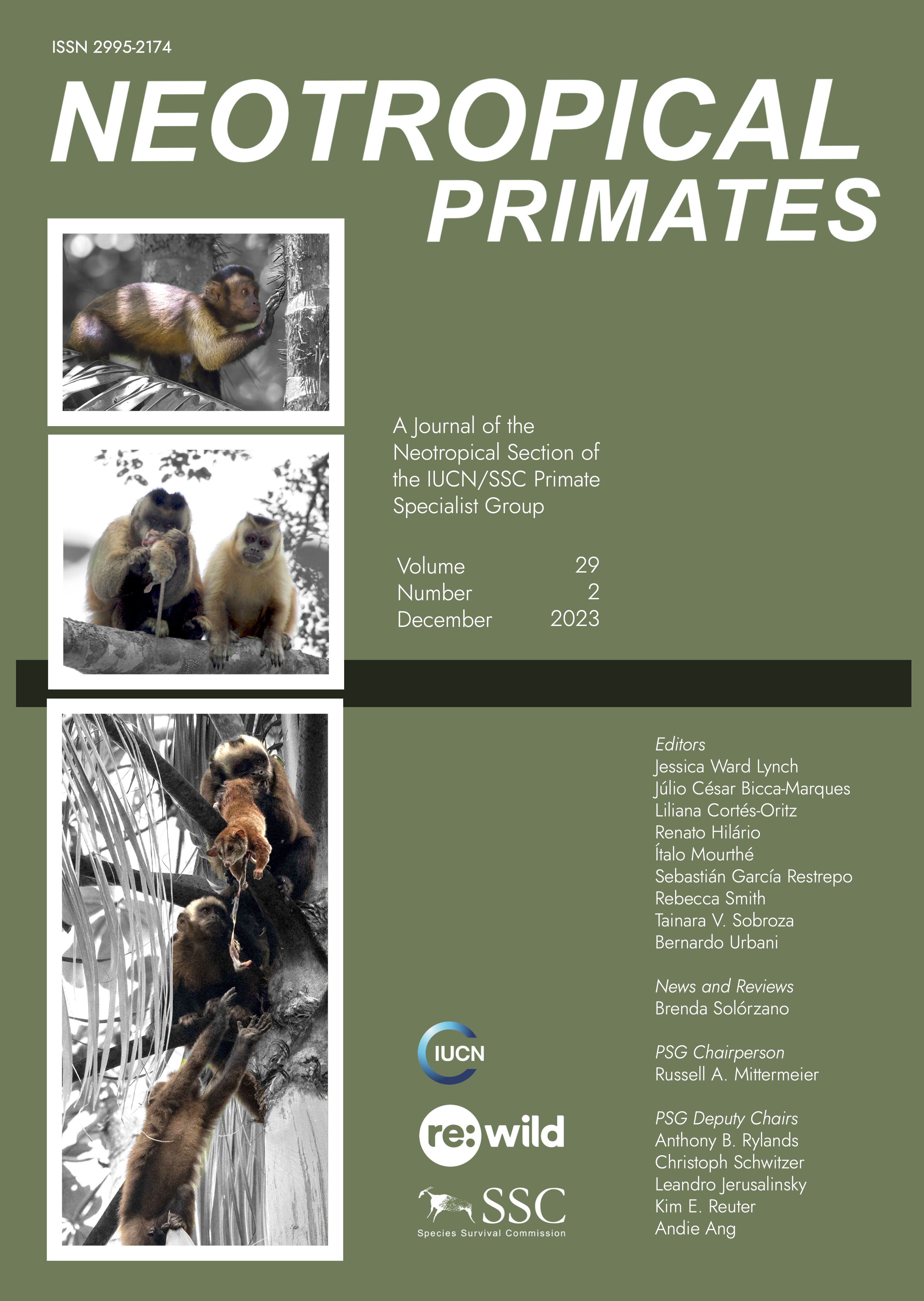First record of Peruvian spider monkeys (Ateles chamek) feeding on a known mushroom species, Oudemansiella canarii (Physalacriaceae)
DOI:
https://doi.org/10.62015/np.2023.v29.797Keywords:
mycophagy, primate, diet, Amazon, terra firmeAbstract
A large group of Peruvian spider monkeys, Ateles chamek, was recorded feeding on Oudemansiella canarii mushrooms in Madre de Dios, Peru. The observed spider monkeys were seen foraging for mushrooms on the forest floor where they grew on downed logs. Spider monkeys are ripe fruit specialists that rarely venture to the forest floor, suggesting that these mushrooms could represent an important though seldom consumed food source. Previous accounts of spider monkeys consuming mushrooms are sparse and do not include identification of the fungi. O. canarii mushrooms have a relatively high protein content, possible immunological benefits, and are present during times of relative fruit scarcity in the region. These reasons could explain why the spider monkeys risked a visit to the forest floor to forage for O. canarii mushrooms.
References
Acharya, K., Nandi, S. and Dutta, A. K. 2019. Microanatomical and physicochemical characterization and antioxidative activity of methanolic extract of Oudemansiella canarii (Jungh.) Höhn. Turk. J. Pharm. Sci. 16: 76. https://doi.org/10.4274/tjps.19981
Anke, T. 1997. Strobilurins. In: Fungal Biotechnology, T. Anke (ed.), pp.206–212. Chapman & Hall, Weinhein, London.
Aureli, F. and Schaffner, C. M. 2008. Social interactions, social relationships and the social system of spider monkeys. In: Spider Monkeys: Behavior, Ecology and Evolution of the Genus Ateles, C. J. Campbell (ed.), pp.236–265. Cambridge University Press, Cambridge.
Campbell, C. J., Aureli, F., Chapman, C. A., Ramos-Fernández, G., Matthews, K., Russo, S. E., Suarez, S. and Vick, L. 2005. Terrestrial behavior of Ateles spp. Int. J. Primatol. 26: 1039–1051. https://doi.org/10.1007/s10764-005-6457-1
Castellanos, H. G. and Chanin, P. 1996. Seasonal differences in food choice and patch preference of long-haired spider monkeys (Ateles belzebuth). In: Adaptive Radiations of Neotropical Primates, M. A. Norconk, A. L. Rosenberger, and P. A. Garber (eds.), pp.451–466. Springer New York, New York.
Chapman, C. 1987. Flexibility in diets of three species of Costa Rican primates. Folia Primatol. 49: 90–105. https://doi.org/10.1159/000156311
Di Fiore, A., Link, A. and Dew, J. L. 2008. Diets of wild spider monkeys. In: Spider Monkeys: Behavior, Ecology and Evolution of the Genus Ateles, C. J. Campbell (ed.), pp.81–137. Cambridge University Press, Cambridge.
dos Santos-Barnett, T. C., Cavalcante, T., Boyle, S. A., Matte, A. L., Bezerra, B. M., de Oliveira, T. G. and Barnett, A. A. 2022. Pulp Fiction: Why some populations of ripe-fruit specialists Ateles chamek and A. marginatusprefer insect-infested foods. Int. J. Primatol. 43: 384–408. https://doi.org/10.1007/s10764-022-00284-0
Emmons, L. H. and Stark, N. M. 1979. Elemental composition of a natural mineral lick in Amazonia. Biotropica 11: 311–313. https://doi.org/10.2307/2387925
Felton, A. M., Felton, A., Raubenheimer, D., Simpson, S. J., Foley, W. J., Wood, J. T., Wallis, I. R. and Lindenmayer, D. B. 2009. Protein content of diets dictates the daily energy intake of a free-ranging primate. Behav. Ecol. 20: 685-690. https://doi.org/10.1093/beheco/arp021
Gautier-Hion, A., Emmons, L. H. and Dubost, G. 1980. A comparison of the diets of three major groups of primary consumers of Gabon (primates, squirrels and ruminants). Oecologia 45: 182–189. https://doi.org/10.1007/BF00346458
Griffiths, B. M., Jin, Y., Griffiths, L. G. and Gilmore, M. P. 2023. Physical, landscape, and chemical properties of Amazonian interior forest mineral licks. Environ. Geochem. Health 45: 3263–3276. https://doi.org/10.1007/s10653-022-01412-8
Guillotin, M., Dubost, G. and Sabatier, D. 1994. Food choice and food competition among the three major primate species of French Guiana. J. Zool. 233: 551-579.https://doi.org/10.1111/j.1469-7998.1994.tb05365.x
Hanson, A. M., Hodge, K. T. and Porter, L. M. 2003. Mycophagy among primates. Mycologist 17: 6–10. https://doi.org/10.1017/S0269-915X(03)00106-X
Klein, L. L. and Klein, D. 1977. Feeding behavior of the Colombian spider monkey, Ateles belzebuth. In: Primate Ecology: Studies of feeding and ranging behavior in lemurs, monkeys, and apes, T. H. Clutton-Brock (ed.), pp.153–181. Academic Press, New York.
Link, A., Galvis, N., Fleming, E. and Di Fiore, A. 2011. Patterns of mineral lick visitation by spider monkeys and howler monkeys in Amazonia: are licks perceived as risky areas? Am. J. Primatol. 73: 386-396. https://doi.org/10.1002/ajp.20910
Petersen, R. H. and Hughes, K. W. 2010. The Xerula/Oudemansiella complex (Agaricales). Nova Hedwig. Beih. 137: 625.
Porter, L. M. 2001. Dietary differences among sympatric Callitrichinae in northern Bolivia: Callimico goeldii, Saguinus fuscicollis and S. labiatus. Int. J. Primatol. 22: 961–992. https://doi.org/10.1023/A:1012013621258.
Roca, M. R. G. 2016. Contribución al conocimiento de los macrohongos en la provincia de Tambopata-Madre de Dios, Perú. Doctoral dissertation, Universidad Politécnica de Madrid, Madrid, Spain.
Rosa, L. H., Cota, B. B., Machado, K. M., Rosa, C. A. and Zani, C. L. 2005. Antifungal and other biological activities from Oudemansiella canarii (Basidiomycota). World J. Microb. Biot. 21: 983–987. https://doi.org/10.1007/s11274-004-7553-7
Ruegger, M. J. S., Tornisielo, S. M. T., Bononi, V. L. R. and Capelari, M. 2001. Cultivation of the edible mushroom Oudemansiella canarii (Jungh.) Höhn. in lignocellulosic substrates. Braz. J. Microbiol. 32: 211–214.
Shimooka, Y. 2005. Sexual differences in ranging of Ateles belzebuth belzebuth at La Macarena, Colombia. Int. J. Primatol. 26: 385–406. https://doi.org/10.1007/s10764-005-2930-0
Simmen, B. and Sabatier, D. 1996. Diets of some French Guianan primates: food composition and food choices. Int. J. Primatol. 17: 661–693. https://doi.org/10.1007/BF02735260
Suarez, S. A. 2006. Diet and travel costs for spider monkeys in a nonseasonal, hyperdiverse environment. Int. J. Primatol. 27: 411-436. https://doi.org/10.1007/s10764-006-9023-6
Symington, M. M. 1987. Ecological and social correlates of party size in the black spider monkey, Ateles paniscus chamek (South America). Doctoral dissertation, Princeton University, Princeton, USA.
van Roosmalen, M. G. 1985. Habitat preferences, diet, feeding strategy and social organization of the black spider monkey [Ateles paniscus paniscus Linnaeus 1758] in Surinam. Acta Amazon. 15: 7–238. https://doi.org/10.1590/1809-43921985155238
Wallace, R. B. 2005. Seasonal variations in diet and foraging behavior of Ateles chamek in a southern Amazonian
tropical forest. Int. J. Primatol. 26: 1053–1075. https://doi.org/10.1007/s10764-005-6458-4
Xu, F., Li, Z., Liu, Y., Rong, C. and Wang, S. 2016. Evaluation of edible mushroom Oudemansiella canarii cultivation on different lignocellulosic substrates. Saudi J. Biol. Sci. 23: 607–613. https://doi.org/10.1016/j.sjbs.2015.07.001
Downloads
Additional Files
Published
Issue
Section
License

This work is licensed under a Creative Commons Attribution-NonCommercial-ShareAlike 4.0 International License.



